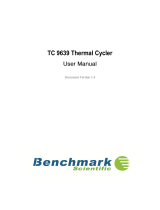Page is loading ...

Operations Manual
Item: C2000
Introduction:
Thank you for purchasing the
PlateFuge™ MicroPlate
Microcentrifuge. Please read this
manual thoroughly
prior to operating the instrument.
The PlateFuge is designed for low
speed applications and quick spin
downs of PCR plates and microtitre
plates. An adapter carrier is also
available for 0.2ml PCR strips and
tubes.
Installation:
Place the PlateFuge on a flat and level
surface nearby an electrical outlet. It
should not be near a heat source or in direct
sunlight.
Operation:
- Attach the power cord and place the
power switch into the on “l” position.
- Open the lid and load your samples into
the included rotor. Always ensure a
balanced load.
NOTE: The centrifuge should never be
started with one plate or two plates that
are not equally balanced. Additional
information can be found in the
following section of this manual,
“Loading the Rotor”.
- Close the lid, the rotor quickly
accelerates to the maximum speed of
2200 rpm. The plate carriers
automatically swing out to a fully
horizontal position, resulting in even
spin downs that will be concentrated at
the bottom of the plate wells.
- When the desired run time is
completed, pull on the lid tab to open
the lid, the rotor quickly brakes to a
stop and the samples can be retrieved.
NEVER Attempt: to remove samples
until the rotor has come to a complete
stop.
Specifications:
Speed: 2100 rpm / 400xg
Capacity: 2 x PCR Plates (or microplates)
192 x 0.2ml or 24 x PCR strips
Dimensions: 9.2(W) x10.2(D) x 7.75(H) in.
23(W) x 26(D) x 19.7(H) cm
Electrical: 120V or 230V, 50-60 Hz
Max. Radius: 8.0cm
Loading the Rotor:
To ensure safe operation and long life of
the instrument, samples must always be
loaded into the rotor in a balanced fashion.
Plates must always be loaded in the center of
the carrier. When loading non-skirted plates,
it is important to line up the wells of the
plate with those shown on the plate carrier.
Starting the centrifuge with the plates not
properly centered will result in an
unbalanced load and increased vibration.
Example of properly balanced rotor:
Example of improperly balanced rotor:
Cleaning and Maintenance:
The centrifuge rotor can be removed for cleaning by
using the included allen wrench to loosen the set
screw. Once removed, the rotor can be cleaned
/




